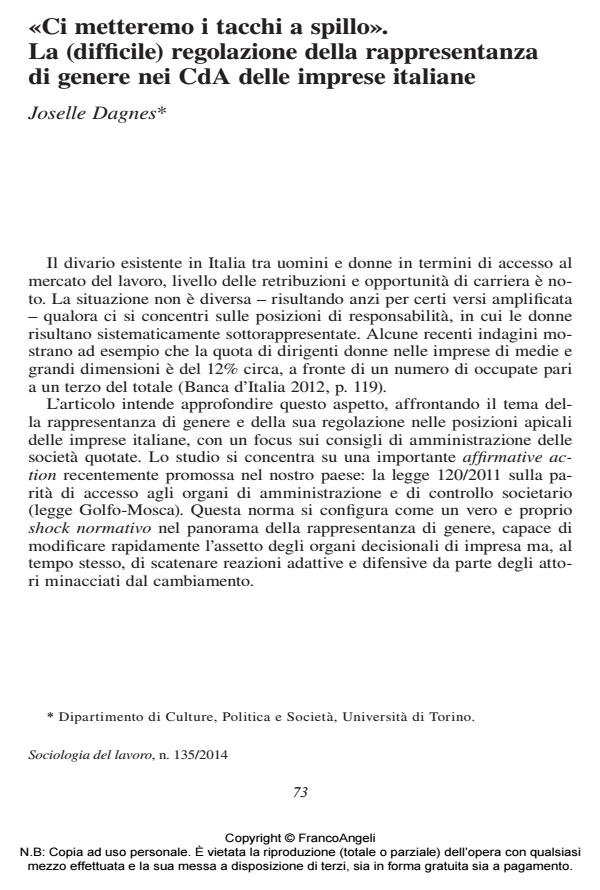"We may have to wear high heel shoe". Critical aspects in the Italian gender quota regulation for private companies’ boards of directors
Journal title SOCIOLOGIA DEL LAVORO
Author/s Joselle Dagnes
Publishing Year 2014 Issue 2014/135
Language Italian Pages 16 P. 73-88 File size 114 KB
DOI 10.3280/SL2014-135005
DOI is like a bar code for intellectual property: to have more infomation
click here
Below, you can see the article first page
If you want to buy this article in PDF format, you can do it, following the instructions to buy download credits

FrancoAngeli is member of Publishers International Linking Association, Inc (PILA), a not-for-profit association which run the CrossRef service enabling links to and from online scholarly content.
This paper is a contribution to explore transformations in the governing body due to the introduction of gender quotas for Italian private company boards. Our aim is to outline the concrete implementation of the Italian quota law, highlighting obstacles, challenges and failure risks. We specifically focus on the perspective of the insider directors and on the impact of quota regulation on boards’ structural features, internal composition and overall quality, focusing on both positive and negative aspects.
Keywords: Board of directors, affirmative actions, gender quotas, corporate governance, power, informal regulation
- Adams R.B., Ferreira D. (2009). Women in the boardroom and their impact on governance and performance. Journal of Financial Economics, 94: 291-309.
- Bacchi C.L. (1996). The Politics of Affirmative Action: ‘Women’, Equality and Category Politics. London: Sage.
- Banca d’Italia (2012). Relazione annuale sul 2011. Roma: Divisione Editoria e stampa della Banca d’Italia.
- Beccalli B. (1999). Donne in quota. La politica delle quote nel lavoro e nella rappresentanza politica. In: Beccalli B., a cura di, Donne in quota. È giusto riservare posti alle donne nel lavoro e nella politica? Milano: Feltrinelli.
- Dagnes J. (2013). Struttura sociale e esiti economici. Il caso del mercato azionario italiano. Rassegna Italiana di Sociologia, 1: 29-56. DOI: 10.1423/73573
- D’Amico M., Puccio A. (2013). Le quote di genere nei consigli di amministrazione delle imprese. Milano: FrancoAngeli.
- D’Ascenzo A. (2011). Fatti più in là. Donne al vertice delle aziende: le quote rosa nei cda. Milano: Il Sole 24 ORE.
- Dworkin R. (2010). I diritti presi sul serio. Bologna: il Mulino.
- EPWN - European Professional Women’s Network (2010). 2010 EPWN Board Women Monitor. Testo disponibile al sito: www.europeanpwn.net (marzo 2014).
- Gilbert J.A., Stead B.A., Ivancevich, J.M. (1999). Diversity management: a new organizational paradigm. Journal of business ethics, 21: 61-76.
- Nespor S. (1999). Politica delle quote: pro e contro. In: Beccalli B., a cura di, Donne in quota. È giusto riservare posti alle donne nel lavoro e nella politica?. Milano: Feltrinelli.
- Tutte le strade (che) portano qui Efficacia e limiti delle quote di genere nei CdA delle società quotate Domenico Carbone, Joselle Dagnes, in SOCIOLOGIA DEL LAVORO 148/2017 pp.167
DOI: 10.3280/SL2017-148010
Joselle Dagnes, "Ci metteremo i tacchi a spillo". La (difficile) regolazione della rappresentanza di genere nei CdA delle imprese italiane in "SOCIOLOGIA DEL LAVORO " 135/2014, pp 73-88, DOI: 10.3280/SL2014-135005